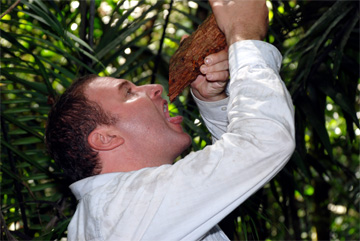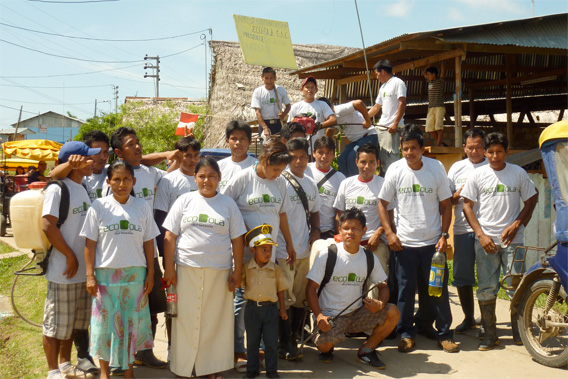
An Eco-Ola permaculture plot with yuca, beans, sacha inchi, bananas, charapitas, herba luisa, and moringa in the Peruvian Amazon.
Communities living in and around tropical forests remain highly dependent on forest products, including nuts, resins, fruit and vegetables, oils, and medicinal plants. But relatively few of these products have been successfully commercialized in ways that generates sustained local benefits. When commercialization does happen, outsiders or a few well-placed insiders usually see the biggest windfall. Large-scale exploitation can also lead to resource depletion or conversion of forests for monoculture-based production. The ecosystem and local people lose.
The situation can be even worse in landscapes that have been completely deforested and subsequently degraded by poor land management. Rural small-holders may suffer from poor soils, which hurt yields and increase dependence on expensive fertilizers and other chemical inputs. Lack of profitability may cause some to move to urban areas or seek jobs on cattle ranches and industrial farms. Others may follow the forest frontier, clearing land for short-term use before moving deeper into rainforest areas. The approach is inherently unsustainable.
This wasn’t always the case. Ancient Amazonians utilized methodologies like permaculture and terra preta (biochar) to farm while enriching soils and even enhancing biodiversity.
A group in Peru is now working to embrace elements of this lost approach and in the process reduce small-holder deforestation, restore the quality of degraded tropical soil, and diversify and strengthen rural livelihoods. Eco Ola, a Peru-based organization founded by William Park and Carla Noain, has developed a community training center in the Peruvian Amazon to train people to learn how to improve soil in a polyculture/agroforestry system. Permaculture essentially mimics the form and structure of a natural forest, with a diverse array of species including a canopy of timber and fruit trees; an understory of cacao, bananas and species; and a shrub layer of herbs, legumes, and peppers. Eco Ola also runs a small non-wood forest products venture with indigenous communities.
William talked about his work in a May 2012 interview with mongabay.com.
Mongabay.com: What led to your interest in Amazonian products?
 William Park drinking from a liana or woody vine. |
William Park, Eco Ola: I first went to Peru with the intention of film making to raise awareness of the plight of isolated tribal groups and of ecological destruction. I quickly realized that awareness doesn’t translate into solutions. I was amazed by how good some of the foods and medicines I tried were and that they were not available outside the region. On my overland treks into the primary jungle, starting from towns near larger rivers I saw the process of degradation. Nearest the towns I saw deforested land being used as low quality pasture able to sustain only small numbers of sorry looking cattle; followed by the small farms of settlers growing bananas and yuca without any replenishment of the soil; then forest with the valuable trees removed; and finally undisturbed primary forest. The bigger the town the longer the walk to get to the primary jungle. I knew that if the land between the towns and the forest could be made productive again the cycle of degradation would be broken. With my wife Carla we founded Eco Ola to implement permaculture solutions that address community needs while offering delicious healthy products for everyone to enjoy.
Mongabay.com: What products are you working with?
 Farmers in the Amazon have used mounds and circles to cultivate crops since pre-Columbian times. Eco-Ola says it does the same thing, calling the mounds swales and the circles, banana circles. |
William Park, Eco Ola: The main principle of permaculture is self-reliance and producing your own food, fiber, shelter and medicine. So we start with local staples such as three types of yuca, five types of bananas, beans, sweet potatoes, peppers, spices..etc. We also grow regional crops like cocona, achiote, and herba luisa. Our main export crop is sacha inchi but we are also producing heritage cacao. We are also starting to work with some non timber forest products like sangre de grado, copaiba, chuchuhuasi, and clavo huasca.
Mongabay.com: Who are your local partners? Are you working with campesinos or indigenous people?
William Park, Eco Ola: We are working with a community an hour outside of Iquitos. The wife of our partner is a member of the Yagua community and is the first generation removed from isolation in the primary jungle. Others in the community were displaced from the mountains during the Fujimori years and are the first generation in the region. We have to be careful not to foster divisions in the community, everyone living there is equally important. I have become friends with some tribal groups over the years but we are moving very carefully to insure our interactions are beneficial and that they understand what we are doing and are eager participants. The visitor/training center is a key part of this process.
Mongabay.com: A study published in Nature in 1989 concluded that forest products from the Amazon were not only economically viable but far outperformed other commodities. But subsequent research cast doubt on those claims, noting transportation costs, transaction costs, and lack of markets for such products. What have you found? Can forest products be viable? What is key to making them so?
 Boat used to bring product to Eco Ola’s processing facility.
|
William Park, Eco Ola: This is a question of implementation and execution. Extractive industries have been operating in the region for decades, granted they are free of ethical constraints, but they have overcome the logistical challenges. The lack of infrastructure makes getting our products to market challenging and expensive. We compensate by being very efficient in our production and not using expensive chemical inputs. The goal is to build a triple canopy food forest that self-assembles. Our new site, where we are working and offering the permaculture course, started with no soil and erosion channels everywhere. It takes a lot of work to get the erosion under control and begin the soil building process. Now we are ready to continue our work toward the self-assembly. Working on sites that are less degraded will make this easier and as we learn more about the soil building process we will become more efficient.
Forest products are very viable. Let me be clear that I don’t consider anything produced in a monoculture plantation to be a forest product. Our vision is to use the knowledge of the local communities to harvest the appropriate amount of bark, root, leaf, resin, or stems from trees in the primary jungle in lieu of cutting trees down. The timing has to be right to make sure the product is potent. This depends on the time of year, time of day, location of the tree…etc. Once the raw material is sourced in this way then the communities have to be involved in the processing to make sure the value chain is sustainable as well. We have made a lot of progress on in this area but we have not developed it as much as the agroforestry parts of our work. The challenge is that so many companies tout themselves as “working with the communities” but they have no operations in the Amazon whatsoever and they purchase by-products of the timber mills for cheap from disreputable brokers in Lima. Their costs are low and they make large profits, but the end products are low in quality hurting the future growth of the market. Once consumers understand how these products can be produced with the communities and see how effective they are the market will grow as the demand for effective natural products is enormous.
Mongabay.com: The acai market is often touted as an example of a large-scale sustainable forest product (often by murky multi-level marketing schemes that promote acai in the U.S.), but there are some indications that this might not be completely accurate. What does it take to ensure large-scale product is sustainable?
William Park, Eco Ola:
I’m not aware of any acai that is grown in an agroforestry system but I’m not an expert on acai. From an ecological perspective a large monoculture palm plantation is the same whether it’s producing fruit pulp or oil. However, I do believe that the acai boom is helping with economic development of the rural poor in Brasil and is a huge improvement compared to transgenic soy disasters.
 Carla Noain (right) laying out swales on contour. |
I think scalability and implementation are the keys to sustainability. So many seemingly intelligent people always talk about big scale and “high level” programs without attention to the micro-scale where all the action takes place. Unfortunately nature doesn’t work that way, macro structures are built from micro-structures thus effective programs must build a micro-structure first. We only manage 130 acres but we are doing it in a way where we can expand using the same methods. I call it a “distributed network of small farms”, where the farms are not physically together, but they are integrated to achieve economy of scale. The implementation aspect means having partners and managers who are committed to the goals and are on the ground to make sure that things are done correctly.
Mongabay.com: What are your biggest challenges?
William Park, Eco Ola:

|
From the local people’s perspective they have been exploited and robbed by a long list of outsiders starting with the rubber barons. When we go to talk to communities we can see they are suspicious that we are another another group of flakes or charlatans. It has taken years to gain the trust of the community where we are working. We have done so by spending years there and working side by side with them. Once we have our visitors center we can invite other communities to come see our work and they can find out all about us from the people we are already working with. This way we can expand efficiently.
The other challenge is green-washing. I see so many companies from Monsanto to McDonalds using their great relationships with farmers to market their products. Many small distributors use brokers and sourcing agents to get their materials. They have no legal entity or operations in Peru. They are able to cut costs by having collectors go around and rip off small farmers and then claim they are working with farmers. This is one reason we are interested in having people come to see for themselves how we are integrated with our farmers.
Mongabay.com: Where can people buy your products?
William Park, Eco Ola:
We are currently selling our products in bulk but we are starting to offer retail products. If anyone is interested in our products you can join our mailing list or follow us on Facebook. If you would like try all of our products please join us in July for the jungle adventure/permaculture course.

Related articles








